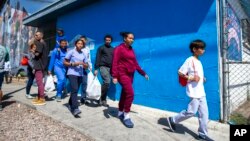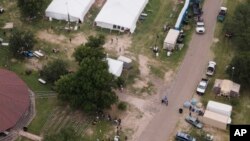The border between the U.S. and Mexico was relatively calm Friday, offering few signs of the chaos that had been feared following a rush by worried migrants to enter the U.S. before the end of pandemic-related immigration restrictions.
Less than 24 hours after the Title 42 rule was lifted, migrants and government officials were still assessing the effect of the change and the new regulations adopted by President Joe Biden's administration to stabilize the region.
"We did not see any substantial increase in immigration this morning," said Blas Nunez-Neto of the Department of Homeland Security. He said the agency did not have specific numbers because it was early in the day.
Migrants along the border continued to wade into the Rio Grande to take their chances at getting into the U.S. while defying officials shouting for them to turn back. Others hunched over cellphones, trying to access the appointment app that is a centerpiece of the new measures. Migrants with appointments walked across a bridge hoping for a new life. And lawsuits sought to stop some of the measures.
Migrants are now essentially barred from seeking asylum in the U.S. if they did not first apply online or seek protection in the countries they traveled through. Families allowed in as their immigration cases progress will face curfews and GPS monitoring.
Across the river from El Paso in Ciudad Juarez, many migrants watched their cellphones in hopes of getting a coveted appointment to seek entry. The application to register to enter the U.S. had changed, and some were explaining to others how to use it.
Nearby, other migrants were charging their phones on a lamppost to try to get an appointment. Most of them were resigned to wait.
The legal pathways touted by the administration consist of a program that permits up to 30,000 people a month from Haiti, Cuba, Nicaragua and Venezuela to enter if they apply online with a financial sponsor and enter through an airport.
About 100 processing centers are opening in Guatemala, Colombia and elsewhere for migrants to apply to go to the U.S., Spain or Canada. Up to 1,000 can enter daily through land crossings with Mexico if they snag an appointment on the app.
If it works, the system could fundamentally alter how migrants come to the southern border. But Biden, who is running for reelection, faces withering criticism from migrant advocates, who say he's abandoning more humanitarian methods, and from Republicans, who claim he's soft on border security.
Melissa Lopez, executive director for diocesan migrant and refugee services at El Paso, said the streets were calm Friday, with few migrants present.
After talking with many migrants, she said they were willing to follow the pathway created by the federal government, but there is also fear about deportation and possible criminal penalties for people who cross the border illegally.
The lull came after days in which large numbers of migrants crossed the border in hopes of being allowed to stay in the United States before the Title 42 restrictions expired.
Farther west, hundreds of migrants, mostly families, sat in two dozen rows between the border walls between San Diego and Tijuana, Mexico, as Border Patrol agents walked among them and selected who would be allowed to leave to be processed. When some got up with them, those left behind cheered.
Gloria Inigo of Peru said she hoped her family would be next. Inigo, her husband and two girls, ages 5 and 8, crossed the border Wednesday before the new rules went into effect. She said she had heard about the rules and wanted to get in before then, but she was surprised so many others were doing the same thing.
"I have faith," she said of being able to get asylum in the U.S.
The expired rule, known as Title 42, has been in place since March 2020. It allowed border officials to quickly return asylum-seekers back over the border on the ground of preventing the spread of COVID-19. The U.S. has declared the national emergency over, ending the restrictions.
While Title 42 prevented many from seeking asylum, it carried no legal consequences, encouraging repeat attempts. After Thursday, migrants face being barred from entering the U.S. for five years and possible criminal prosecution.
Border Patrol chief Raul Ortiz said Friday in a tweet that the agency had apprehended 67,759 people in the last week. That averages out to 9,679 per day — nearly twice the average daily level of 5,200 from March.
It's slightly below the 11,000 figure that authorities said was the upper limit of what they expected after Title 42 ended, but it wasn't clear where numbers peaked in the hours before Title 42 expired Thursday night.
"We're seeing precisely the challenge we expected," Homeland Security Secretary Alejandro Mayorkas said Friday on ABC's "Good Morning America." "We cannot control the movement of people before they reach our border."
Border holding facilities were already far beyond capacity in the run-up to Title 42's expiration. Officials had orders to release people with a notice to report to an immigration office in 60 days if facilities reached 125% capacity or when they were held 60 hours or more. The quick releases were also to be triggered when authorities stopped 7,000 migrants along the border in a day.
But late Thursday, a federal judge appointed by former President Donald Trump temporarily halted the administration's plans to release people into the U.S. and set a court date on whether to extend the ruling. Customs and Border Protection said it would comply but called it a "harmful ruling that will result in unsafe overcrowding."











